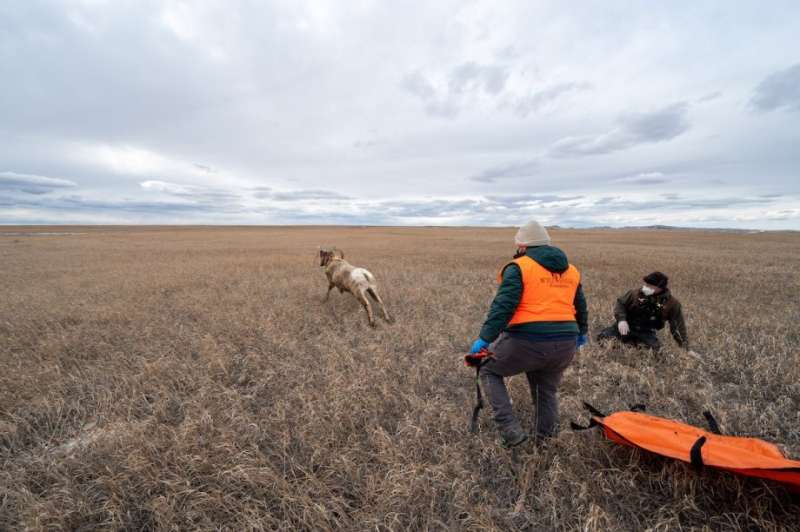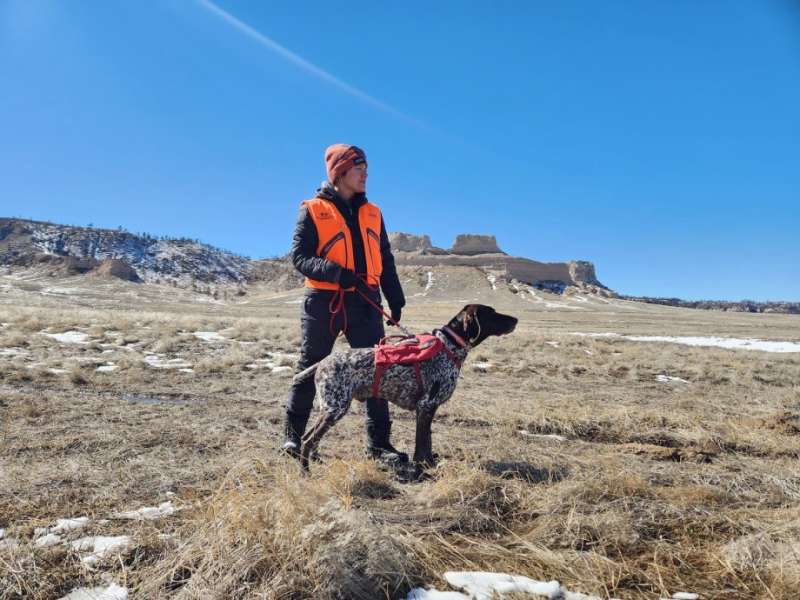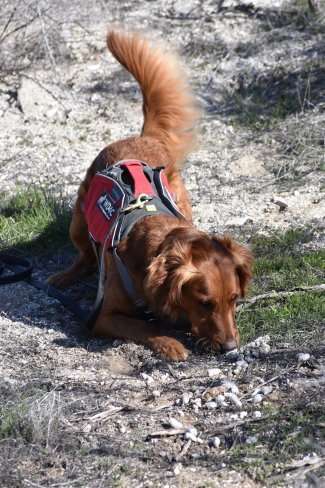This article has been reviewed according to Science X's editorial process and policies. Editors have highlighted the following attributes while ensuring the content's credibility:
fact-checked
trusted source
proofread
Can disease-detecting dogs help save South Dakota's bighorn sheep?

In summer 2021, Badlands National Park was home to a healthy and growing population of Rocky Mountain bighorn sheep, with approximately 300 total among the three herds. Then in August, Paul Roghair, lead biological science technician for the park, came across a dead sheep. In September, he found a dead ram. Roghair had a sinking feeling about what might be afoot.
"I thought, 'Oh no, we might have a situation,'" Roghair said.
Early testing revealed a worst-case scenario: The sheep had contracted a deadly, pneumonia-causing bacteria—Mycoplasma ovipneumoniae—that nearly wiped out a herd located in Custer State Park in the early 2000s.
Pneumonia quickly spread throughout the rest of the three herds, and wildlife officials began to notice bighorns coughing regularly. Within three months, 50% of the radio-collared sheep were dead.
"We were finding sheep everywhere," Roghair, a 2006 South Dakota State University wildlife and fisheries sciences graduate, said. "We lost a lot of them."
Three years later, with nearly 85% of the population lost, about 50 bighorns remain in the park. While there is no vaccine or treatment for Mycoplasma ovipneumoniae, researchers in SDSU's Department of Natural Resource Management have joined a collaborative, National Park Service-funded project among the South Dakota Department of Game, Fish and Parks and the Oglala Sioux Parks and Recreation Authority to find solutions in slowing the current problem and preventing future outbreaks.
Tumultuous history in South Dakota
Prior to European settlement, Audubon's bighorn sheep (Ovis canadensis auduboni) were common in the Badlands and Black Hills regions of South Dakota. But, by 1887, bighorns had all but been "cleared out" of the state and now, Audubon's are an extinct subspecies. Unregulated hunting and domestic livestock grazing are believed to be the primary culprits in their demise.
In 1922, Peter Norbeck, South Dakota's ninth governor and a three-term U.S. senator, obtained eight Rocky Mountain bighorns (Ovis canadensis canadensis) from Alberta, Canada, which were released into Custer State Park. This was the first of many translocation and repopulation efforts for bighorn sheep in South Dakota.
Their tumultuous history has been marked by periods of growth and die-offs. Take, for example, Norbeck's herd. It flourished in Custer State Park up until the 1950s, when the population suddenly went into a decline and, eventually, was completely lost due to "unknown reasons."
In 1964, Badlands National Park received its first translocation herd of bighorn sheep, when 22 bighorns were relocated from Pike's Peak, Colorado. The park received a second herd from Wheeler Peak, New Mexico, in 2004.
Other herds in the Black Hills have also seen periods of growth, followed by periods of decline and, in some cases, total population loss. Almost all these deaths can be chalked up to accidents (usually vehicular) or Mycoplasma ovipneumoniae outbreaks within herds.
In the United States, there are approximately 80,000 Bighorn sheep.

Current situation
So what happened in this latest die-off? How did the bighorns become infected?
According to William Severud, assistant professor in SDSU's Department of Natural Resource Management, it is suspected that a ram, or group of young rams, interacted with a domestic sheep unit north of the park.
"What happened was that some of the sheep left the park and comingled with domestic sheep," Severud said. "That's where they likely came in contact with the disease. They brought it back to the park and passed it around to the rest of the herd. A lot of them died outright."
Domestic sheep (and goats) are carriers of Mycoplasma ovipneumoniae and are seemingly unaffected by the bacterium. But for wild sheep, pneumonia is a death sentence, with mortality rates hovering between 50% and 80% for infected bighorns.
For bighorns that do survive an infection, the future is lonely. Outbreaks within a population subsequently cause low lamb recruitment, meaning herds have difficulty repopulating.
"The survivors of the pneumonia either clear the bacteria or they become chronic carriers of it," Severud explained. "The bacterium still lives in their nasal cavity. When the lambs are born in the spring, they have some immunity from their mother's milk, but after about six weeks, that goes away and basically all the lambs die. So, it not only eliminates 50% of the herd, it also suppresses reproduction for survival."
With no treatment available, one of the ways in which wildlife managers prevent further die-off is to test animals in the herd for the disease. If a positive test is revealed through a nasal swab, the animal will be retested twice more. Three straight positive tests mean the animal is a chronic carrier and is shedding the bacterium, causing other sheep to become infected.
"Removing animals that test positive is one of the only ways to combat this right now," Severud explained.
Training dogs
Since joining on the bighorn recovery project, Severud and his graduate research assistants have made multiple trips to the Badlands for testing and tagging bighorns. One of the current challenges with testing is the cost of capturing and restraining the animals, along with the lag time for getting test results.
Capturing bighorns is done through "helicopter net gunning," which utilizes highly trained pilots and wildlife biologists to capture and restrain the animals for testing. After swabbing the animals' nasal cavities, they ship the specimens to a testing facility in Washington State. Under ideal conditions, results will be available in two weeks.

This capture and testing process is the most efficient method to test and detect disease in bighorns; however, researchers are looking for a more efficient way to test and detect for disease.
Severud and one of his graduate assistants, Michele Lovara, are exploring if trained dogs could be the answer. Previously, dogs have been used to detect a variety of human diseases, including cancer, and the researchers believe they can be trained in a similar way to detect pneumonia in bighorns.
"There's a few different ways to test and detect pneumonia," Severud said. "We are interested in this dog method because that would preclude us from having to swab them and sending them the DNA off to the lab and waiting for results."
Lovara, a master's student at SDSU, is involved with the world's leading conservation dog organization, Working Dogs for Conservation. For the past few months, she has been training the dogs, primarily shelter dogs, to detect bacteria from the swab.
"We are looking at the nasal swabs, but we are also looking at scat because if we can look at scat, we don't have to do the captures at all," Lovara said. "We could do this completely non-invasively, and that would be ideal."
To test their idea, they first trained the dogs to detect bacteria through domestic sheep's scat. The dogs are making accurate detections at a 93% rate. For wild scats, they are making accurate detections at an 80% rate.
"In the lab, they are doing decently well at detection, and next year, we are hoping to test the dogs in the field," Lovara said. "This summer, we will test them in the field with the nasal swabs."
If the dogs can make accurate detections, it would allow wildlife officials to remove infected bighorns from the rest of the herd in a much more efficient and timely manner.
"The issue is some of the animals do get the disease and they are fine. We don't want to remove an animal that has the genetics to get over this disease," Lovara said. "The question becomes, which ones do you remove?"
Solutions
While removing infected sheep from the herd is one way to combat outbreaks, how can they be prevented in the first place?
The best way to combat the disease is keeping livestock and wild sheep separate," Severud said.
Another collaborative project that one of Severud's graduate students is involved with is understanding the movements of individual bighorns and entire herds. Since a large majority of the sheep are collared, the researchers can track their movement in and outside the park.
Previously, an SDSU graduate student, Austin Wieseler, evaluated the population within Badlands National Park for his master's thesis. During field research in 2018, Wieseler identified five domestic goat and sheep populations within 10 miles of the park's boundaries.
"As the population continues to have high survival and growth, disease exposure from contact with livestock appears to be the greatest risk to the population in the future," Wieseler prophetically wrote in spring 2021.
Wild animals are exceedingly difficult to contain and eventually, the sheep comingled with their domestic cousins. To prevent a similar situation in the future, Lovara suspects that dogs could be utilized to keep the groups separate.
"Can we use livestock guardian dogs to stop the disease from spreading?" Lovara said. "That's the preventative measure that we have also been working on."
The issue is that livestock guardian dogs will often only protect their sheep from predators, and according to domestic producers in the area, dogs currently don't see bighorns as predators and will let them commingle with the other sheep. However, anecdotal evidence has shown that if producers chase bighorns away from their herds, guardian dogs will mimic their owner's behavior.
"We think it could be a pretty easy training fix," Lovara said.
Future outlook
While the situation is bleak within Badlands National Park, according to Roghair, there is room for optimism. Fewer bighorns are testing positive, meaning the outbreak is starting to subside.
"We need to clear out the disease from the herds which will help with lamb recruitment," Roghair said. "Then we can get back to a growing and healthy population."
The Badlands are also ideal ground for bighorns as the population—prior to the outbreak—was healthy and thriving. Roghair believes they can again thrive once they get back to a disease-free population.
"We're not out of the woods yet," Roghair said. "But we are making steps in the right direction."
Provided by South Dakota State University



















